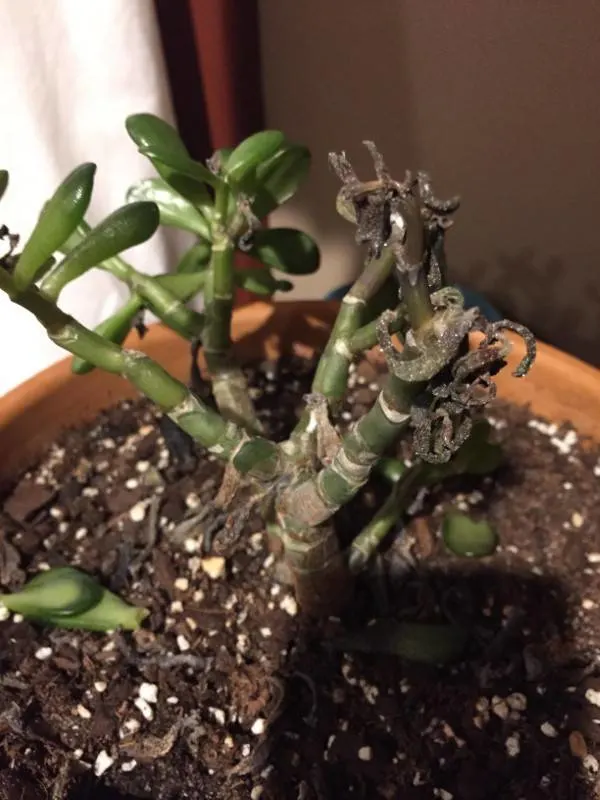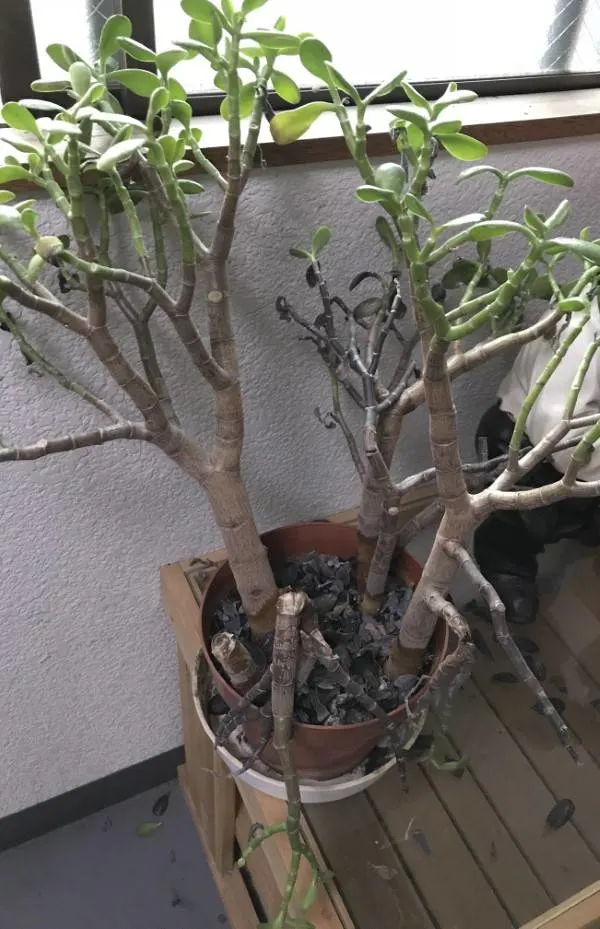Jade plants are members of succulent plants grown throughout the world. They are popular house plants that are easy to care for. Most thrive in indoor environments, even with poor lighting.
As a result, you don’t need much to care for them besides pruning lightly, random watering, and exposing them to indirect sunlight. This, however, doesn’t make them immune to specific issues requiring our help. Therefore, you frequently hear, “Why is my Jade plant dying?”
Why is your jade plant dying? Your jade plant could be dying due to too much moisture around the plant’s root. Too much water in the soil causes yellowing leaves and root rot in jade plants.
If you cannot ascertain the problem, the information provided in this guide will help you figure the problem out and what action to take.

Why Is My Jade plant Dying?
You can determine when your jade plant is faced with stressful conditions quickly. Some signs of this include dropping leaves, leaves changing colors, and a wilting jade plant.
This would cause you to suspect that your jade plant is unhealthy. However, finding out what the problem is might not be so easy. Discover some of the common reasons below.
1. Overwatering
A common reason why your jade plant is dying might be overwatering or staying in moist soil for a long time. This leads to too much moisture at the root of the plant. Jade plants are drought-resistant succulents, and they do not deal well with too much water.
Signs that your jade plant is overwatered include brown or yellow leaves, soft, squishy leaves, falling leaves, or root rot. If you notice these unique signs in your plant, check the soil your jade is potted with.
Jade plants and the potting soil must be allowed to dry out between waterings. Drying helps to prevent root rot that can kill off the jade. However, sitting in water for extended periods causes damage and water stress to the plant.
How To Fix
If the reason for your dying jade plant is due to too much water, quick action is needed to halt its death. First, you want to remove your jade plant from its pot and allow the excess moisture to dry out.
Next, if your plant pot lacks drainage holes, you need to get a pot with drains or create drain holes in the available one to allow the escape of excess water.
Next, you need to get a perlite and cactus mix to repot your jade plant. This soil mix does not hold on to excess water, letting them escape from the bottom of your pot. Repot your jade plant in this new soil mix.
Scale back on how frequently you water your plant. Check the soil before watering and water once you discover that the soil is dry.
2. Underwatering
Another possible reason why your jade is dying can be dying, although this is not such a common reason. When you touch the soil, how does it feel? Is it scorched? How long do you space out watering your plant? You might be underwatering your jade plant if you take a long while between watering schedules.
An underwatered jade plant will present the following signs: falling leaves, curling leaves, wrinkly leaves, and stunted growth. You may have gone overboard with the advice of not over-watering your jade.
How to Fix
Resolving the issue of your dying jade plant is a bit easier to accomplish. Because jade plants are drought-resistant, they already do not require frequent watering. The trick to watering jade plants, like all succulents, is to give deep watering and then allow the soil to dry entirely before the next watering.
It is also essential to develop a consistent timeline for watering them. For example, watering deeply once every two weeks will be enough to keep them from dying. Also, your watering should depend on your jade plant’s size.
3. Root Rot
Root rot, unlike other symptoms, is not easy to detect because they occur underneath the soil. Root rot results from overwatering jade plants, which continue undetected if the soil remains constantly wet. Figuring this out on time is vital in saving your dying jade plant.
You can detect root rot in a jade plant with stunted growth and wilting leaves. Perceiving bed odor from the roots or mushy roots is another sign you may observe. If you don’t take any action, the roots may be damaged, leading to the death of your jade plant.
How to Fix
If you suspect that your jade plant is dying from root rot, the first step you need to take is to remove the plant from the pot. Remove clingy soil from the root and examine it closely. You should cut off brown, mushy roots. Avoid the healthy roots so you do not damage them.
The roots should be cleaned with plain water and bleach to remove the bacteria. Allow the plant and its root to air dry for several hours.
Next, get a new pot with drain holes at its bottom. Using a new soil mix, repot your jade plant. Avoid watering your plant for some days; after that, water thoroughly and allow the excess to drain out.

4. Inconsistent Temperature
Jade plants can adapt quickly to various conditions, but because their natural habitat is usually a hotter climate, they do not handle frigid temperatures well. This may be another reason why your jade plant is dying.
While they can handle low temperatures, they struggle with temperatures lower than 40°F. During winter, keeping them outside can be very damaging, especially with exposure to frost. So although jade plants are adaptable, low temperatures might likely kill them.
Moving jade plants often from one condition to another can be distressing. When keeping them indoors, you should keep them away from the high temperatures of a heating vent. This can result in falling matured leaves.
How to Fix
To revive your jade plant, if you discover that fluctuating temperature is the reason it is dying, attempt to keep it in consistent conditions. When indoors in winter, locate your jade plant in an area with enough ventilation and away from heating systems.
Keep your jade plants away from windows during the winter. Keeping your jade plant a few feet from a furnace is an excellent method to keep it warm. Temperature ranges of 65°F-85°F suit jade plants, though they can tolerate as low as 40°F.
5. Plant Pest
Pest infestation is a significant threat to plants and maybe why your jade plant is dying. Common pests that infest jade plants are mealybugs and spider mites.
These pests may eat the leaves and suck the sap out of the plant, weakening it. If left untreated, the health of the jade plant will deteriorate, resulting in possible death.
One of the worst pests of the jade plant is the mealybugs. They take a long to discover because of their tiny size and white color. The presence of mealybugs on your jade plant can also be mistaken for dust because of the cotton-like patches they create.
Mealybugs also facilitate the growth of fungal diseases due to the secretion of honeydew, a sticky substance.
How to Fix
Check your jade plant to see if you find telltale signs of pest infestation like holes on leaves and stems, tiny insects, or cotton-like substances. If you discover any of this, you likely have a case of pest infestation. Luckily, quick action can save your plant.
If you need to eliminate the pests immediately, you can pick them off the plant by hand. You can usually find them at the junction between the leaves and stems. Prune off the damaged parts of the jade plant, as this will also rid the plant of pests.
A second way to get rid of the pests is by spraying isopropyl (70%) alcohol all over the plant surface, particularly at the junctions where leaves and stems meet. You may also apply alcohol with a soaked swab by wiping down the entire plant.
Thirdly, mix a liter of water with two tablespoons of neem oil to create a spray to eliminate the pests. A fourth option will be the use of pesticides if other options fail. They are designed to remove pests without damaging the plant.
6. Humidity
Jade plants are usually grown in dry environments, which not all owners can guarantee. However, in most homes, the humidity levels are moderately high, and when you keep jade plants with other indoor plants, the moisture levels are even higher.
These humidity levels could prove to be a problem for jade plants. A jade plant is susceptible to fungal infection and other problems when too humid.
How to Fix
You would need to discover and maintain the proper humidity levels around your jade plant, usually between 30-50%. Although, there’s space for slight variation in the humidity levels, as it will not harm the jade plant.
If you grow other plants that love humidity, you need to keep your jade plants away from them as they will increase the humidity levels. Also, ensure to move your jade plant to a well-lit space to reduce the humidity around them.
7. Sunlight
Jade plants will also die if kept in the wrong lighting conditions. Bright light, however, is beneficial, and they are also adaptable to a variety of other conditions. If kept in unfavorable conditions, the jade plant’s growth and development will be compromised.
You’ll know that your jade plant is getting too much sunlight if you observe sunburns and brown spots. Also, you can tell when the jade plant is getting less than the ideal amount of sunlight through slow growth, leggy growth, and yellow leaves.
How to Fix
You can resolve the issues of too much lighting through the following process. First, move your jade plant to a shaded area to reduce the direct intensity of sunlight on them if they are outdoors. You also want to move your plant a few feet away if it is placed near a window. Or use a light curtain to cover the window.
Too little sunlight can be resolved by moving your plant to an area with better sunlight exposure. If located indoors where natural light is low, consider moving your plant to a shaded area outdoors.
Artificial light may also serve your plant’s needs. Do not forget to rotate your plant often to get even sunlight and prevent uneven growth.
Conclusion
You might have observed that your jade plant is dying. This could have made you reflect, “Why is my jade plant dying?” Often, your jade plant needs an adjustment in its grooming routine. In our guide above, you will discover the common reasons why your jade plant is dying.
We expect that this informative post will help you figure out the problem with your jade plant. Note the symptoms mentioned in this guide and compare them to your jade plant. These will help you determine the right action to take.
This guide also includes the best possible solutions to each cause, which allows you to nurse your jade plant back to good health. Kindly share your comments and queries with us in the comment section below.
